What is a Shmup?

For some reason, this screen from R-Type is always what I think about when I hear the word “shmup”.
It’s leap day, a day that on most years doesn’t even exist, and had it not been for today it would officially be March. For those of us in the retro gaming world, shooter fans or basically anyone who listens to Drunken Gamers Radio it also means Shmuppreciation month. For 31 long days we show our appreciation for intergalactic starships, Moai heads, tiered power-ups, sexy young girls with large breasts that aren’t involved in a hentai game, dodging thousands of bullets and actually seeing a vertical raster effect in a high-definition game. It is all for the love of the shoot ’em up, these days called “shmups” for short. What’s distinct about the shmup is that aside from most other genres, it has been around as long as video games themselves – yes, the first video game was a shmup – and has remained relatively unchanged for more than 30 years. As an avid fan with probably more than $1,000 in shmups alone among almost every system – did I mention the shmup has some of the most expensive games in existence? – I wanted to reflect on the history of the shmup.
Humble Beginnings
Many different definitions exist for the genre, but I define a shmup as any game where a single entity, usually a space ship but can be substituted for characters or animals, moves about the screen shooting down enemies while being attacked by all of them at once. Plenty of sub-genres exist including the now highly popular “bullet hell” titles as well as “cute ’em ups“, “rail shooters” and even developer-specific game styles like “Cave shooters“. While this article will not get into each sub-genre specifically, you can bet we covered these games in their own articles.
Depending on your definition, the first video game ever created was Spacewar! by MIT students in 1962 on a PDP-1 (we covered the origins of the game here), and of course it was a shmup. Two players would fight simultaneously to destroy one another in open space while also being affected by the gravitational pull of a star. Due to the early nature of the title, there is no way to play the game next to a computer opponent, nor are there any “enemies” per se (unless you count your opponent), but the building blocks of the shmup are there. Later on in time this would be adapted to the arcade version of Computer Space, programmed by Nolan Bushnell of Atari fame, and known as probably the first arcade game, releasing in 1971. In Computer Space you would control a ship using four directional buttons and attempt to out maneuver flying saucers that would fire missiles at you – each hit would result in a point. After 90 seconds if you had a higher score than the saucers the arcade would flip colors – it was only black and white, so it would create the negative of the screen with space being white and the elements being black – for another 90 seconds. It was a commercial failure deemed too technical for casual bar users but generated the next step with a computer opponent.
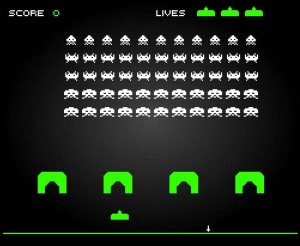
Space Invaders
Atari would go on to create the culmination of both in a game called Asteroids in 1980. Probably one of the most widely known games of all time, Asteroids combined the enemies of Computer Space and the gravitational effect of Spacewar! with the addition of floating asteroids resulting in a truly addictive hybrid. As you can probably already see, the basic building blocks of the staple shmup are coming together, but even Asteroids lacked one important factor of all shmups: lots of enemies. Sure, there may be a saucer or two, but not a screen of enemies. That belonged to the even more popular Space Invaders by Taito, released one year earlier in 1979, and featured literally a screen full of enemies. For those that have not experienced this, you control a single ship that can hide behind 3 destructible barriers as a grid of 5 rows containing 10-11 “invaders” each would descend upon you. Your goal is to eliminate them as quickly as possible, the obvious focus being on the ones closer to the bottom of the screen. If an alien gets through, you lose, simple as that. What resulted was an arcade phenomenon that celebrated so much success that Japan actually had a temporary 100-yen coin (the cost of a single play) shortage and a total gross of over $2 billion by 1982. In 1981 Namco would release a similar title, the also widely popular Galaga, that adapted the format slightly to allow more interaction between the ships and aliens as they would leave formation and attack the ship in random intervals.
Birth of the Shmup
Now we have most of the building blocks of a shmup – lots of enemies, bullet fire, and moving ships – but we still lack one more fundamental part: scrolling. Until around the mid 1980s, scrolling wasn’t a fundamental part of video games whereas by the time the NES released it was an essential part of nearly every title. Some of the first scrolling titles were arcade games with vector graphics, which created a grid-like look that simulated 3D through special monitors that created images with beams of light. The first of this style was Red Baron, which is one of the few decent titles that can still be found in Xbox Live’s Game Room today, and featured an open space to navigate while you moved forward in an on-rails format. Later, in 1983, Atari’s Star Wars would adapt the format to the popular “trench run” scene from the original film and offer yet another early example of the schmup.
Capcom would be one of the first pioneers of the shmup with their 1984 release of the arcade game 1942. As a World War II fighter pilot, all of the elements of the successful vertical shmup would be integrated all at once. In 1942 the player would control a fighter plane that could freely navigate the entire screen to avoid enemies and gunfire while the stages scrolled vertically. Various different types of enemies, each with their own movement pattern and ammunition, would attack the player and each new level introduced a newer and tougher mix of them. The goal was to avoid the bullets and enemies while destroying anything that came on-screen. Even today, most vertical scrolling shmups follow this format.
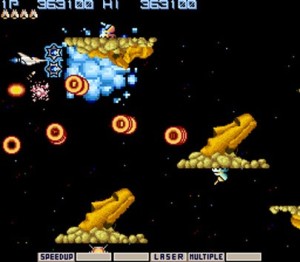 In 1985 Konami would release its own version of the shmup, Gradius, which added in the popular space ship protagonist and the concept of upgrade systems. In Gradius your goal is to destroy ships attacking and shooting at you on a horizontal plane, but just like 1942 you are able to navigate the screen as you see fit. As additional conflict, the levels themselves would be etched in different pathways and have walls, borders and formations that would attempt to crash your ship in addition to the enemies. This title also established the boss battle as the conclusion of each level, making it important to upgrade your ship throughout the level for the challenge ahead. It also established a power-up system – your ship could be upgraded with various weapons and add-ons provided that you collected enough power-ups and added them to the ship. For those that have played Gradius, the ideal setup was usually to get two options (bulbs of energy that trail you and fire bullets), a force field, missiles that attack the ceiling/floor and top speed. Many frequent players can accomplish this on the first level with little issue (or simply put in the Konami code on the pause screen in the NES version), however if you die in Gradius you will lose all add-ons and go back to a checkpoint area somewhere in the level. This is why titles in the Gradius series and many other offshoots are considered “1 life” titles, meaning they’re exponentially easier if you can complete them in 1 life with all upgrades. In my eyes, and in the eyes of many others, the first official shmup was Gradius and sequels are still releasing today (Gradius Rebirth on WiiWare is technically the most recent, although Otomedius on the 360 touts itself a parody of Gradius).
In 1985 Konami would release its own version of the shmup, Gradius, which added in the popular space ship protagonist and the concept of upgrade systems. In Gradius your goal is to destroy ships attacking and shooting at you on a horizontal plane, but just like 1942 you are able to navigate the screen as you see fit. As additional conflict, the levels themselves would be etched in different pathways and have walls, borders and formations that would attempt to crash your ship in addition to the enemies. This title also established the boss battle as the conclusion of each level, making it important to upgrade your ship throughout the level for the challenge ahead. It also established a power-up system – your ship could be upgraded with various weapons and add-ons provided that you collected enough power-ups and added them to the ship. For those that have played Gradius, the ideal setup was usually to get two options (bulbs of energy that trail you and fire bullets), a force field, missiles that attack the ceiling/floor and top speed. Many frequent players can accomplish this on the first level with little issue (or simply put in the Konami code on the pause screen in the NES version), however if you die in Gradius you will lose all add-ons and go back to a checkpoint area somewhere in the level. This is why titles in the Gradius series and many other offshoots are considered “1 life” titles, meaning they’re exponentially easier if you can complete them in 1 life with all upgrades. In my eyes, and in the eyes of many others, the first official shmup was Gradius and sequels are still releasing today (Gradius Rebirth on WiiWare is technically the most recent, although Otomedius on the 360 touts itself a parody of Gradius).
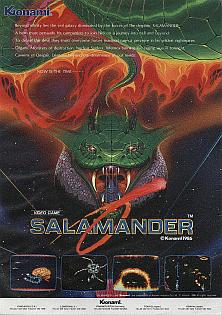
Konami wouldn’t stop there, and in fact the publisher is responsible for some of my favorite shmups to date. Of those, my absolute favorite title is 1986’s Salamander (known better in the US as Life Force) which took the Gradius concept and integrated both vertical and horizontal levels as well as a respawn format to dying instead of returning you to a checkpoint. You were also able to recover your options if you were fast enough with your respawns. To many this makes Salamander the easy version of the shmup, but the biological format to all the levels and bosses combined with the variation of levels makes it my clear favorite. Granted, it has to be much easier because even I have completed the NES version of Salamander in one life before (in this title the Konami code awards you with 30 lives, solidifying that you’ll see the end).
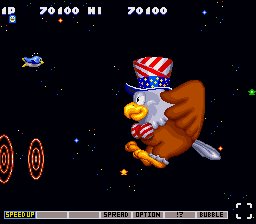 My favorite ongoing series has probably got to be the Parodius series (which may technically also include Otomedius), which many American gamers won’t be familiar with because we never received a single title in the US. These titles are colorful, bubbly cartoon versions of a shmup that tend to have animals, large breasted anime girls and lots of US political jokes (probably why Konami never localized it here, despite releases in Japan and Europe). In addition, it tends to parody the Gradius series (hence the hybrid name Parodius) while still retaining the power-up system and much of the challenge required to succeed (especially with the brutal recent Otomedius). Just like the Gradius series, Parodius has made appearances in arcades and on most major consoles from the Famicom to the Playstation Portable. More than likely this is the first example of the “cute ’em up”.
My favorite ongoing series has probably got to be the Parodius series (which may technically also include Otomedius), which many American gamers won’t be familiar with because we never received a single title in the US. These titles are colorful, bubbly cartoon versions of a shmup that tend to have animals, large breasted anime girls and lots of US political jokes (probably why Konami never localized it here, despite releases in Japan and Europe). In addition, it tends to parody the Gradius series (hence the hybrid name Parodius) while still retaining the power-up system and much of the challenge required to succeed (especially with the brutal recent Otomedius). Just like the Gradius series, Parodius has made appearances in arcades and on most major consoles from the Famicom to the Playstation Portable. More than likely this is the first example of the “cute ’em up”.
Contemporary Shmup
Because of its arcade style and old school mechanics, it’s no surprise that the shmup has lost a lot of momentum in the United States and Europe as a niche genre since the late 90s. This doesn’t mean that games don’t come out, just look at all of the collections that found homes on the portable consoles as well as a slew of solid US Dreamcast shmups and an odd resurgence on Xbox Live, but for many shmup fans there are definitely games with Japanese writing in your collection. In Japan arcades are beginning to ween but held more consistent strength over the last 10 years and the market has seen great success with the genre even now. Shmups have changed greatly and even included vast alterations to the formula, but at the end of the day it’s always a game where a ship blows up tons of enemies while dodging bullets and obstacles. In the United States we’ve seen certain developers take chances, but the failure rate remains constant and high. This is why we have games like Deathsmiles II only digital and only in Japanese, Sin and Punishment 2 on Wii even though the original on N64 never released here (you can get it on Virtual Console though), and the aforementioned Otomedius that picks up the reigns of a series we’ve never seen.
There are far too many shmups to count and depending on how hardcore you are it’s difficult to decide which $60-$120 import you want to take a shot at. Yes, you saw that right, most shmup fans need to adapt their classic consoles to play imports and then drop large wads of cash for a game that will kick their ass and that they may never see the later levels of. You see why this genre can’t succeed in America? Fortunately there are plenty of shmups that beginners can enjoy for low prices and domestic releases, not to mention theemulation scene can open doors previously locked shut. This month we at Gaming History 101 celebrate Shmuppreciation 2012 with the shmup of the day that covers some of the most common and most rare series on the market. Hopefully you will learn a thing or two and even begin to show interest in the shmup genre, or at least see what some of those expensive and cult titles are all about.

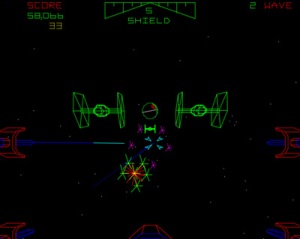
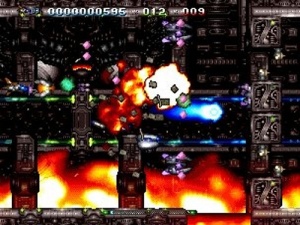
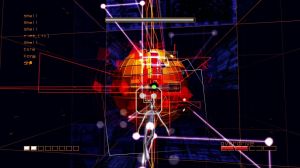
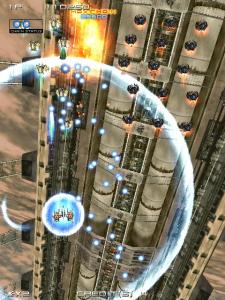
[…] is a love letter to the Darius series as well as anyone who has nostalgia for the shoot-em-up (shmup) genre. This series first started all the way back in 1986 and was infamously known for its […]
The B-Team - Dariusburst Chronicle Saviours Review
December 31, 2015 at 12:05 pm
[…] Rojas, F. (2012) “What is a shmup?” Retrieved from: https://gaminghistory101.com/2012/02/29/shmup/ […]
Week 2 | melasher
May 12, 2016 at 8:13 pm
[…] Rojas, F. (2012) “What is a shmup?” Retrieved from:https://gaminghistory101.com/2012/02/29/shmup/ […]
Week 2 – melasher
August 10, 2016 at 8:51 pm